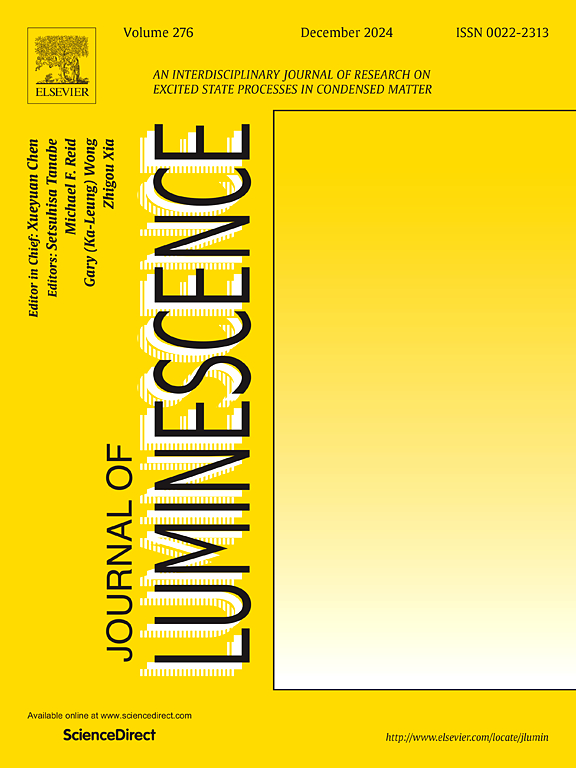Te4+-doped Cs3In2Cl9 zero-dimensional perovskite for high-sensitivity optical thermometry
IF 3.3
3区 物理与天体物理
Q2 OPTICS
引用次数: 0
Abstract
Halide perovskite materials have garnered considerable interest due to their distinctive optical properties and their promise in optoelectronic applications. In this study, we reported the synthesis novel zero-dimensional halide perovskite Cs3In2Cl9:Te4+ via an ultrasonic-assisted method. The structural and photoluminescent properties of the resulting polycrystalline sample were meticulously characterized using X-ray powder diffraction (XRD), Raman spectroscopy, X-ray photoelectron spectroscopy (XPS), and fluorescence spectroscopy. Experimental findings reveal that upon excitation with near-ultraviolet light at 390 nm, the Cs3In2Cl9:Te4+ sample exhibits a bright orange-yellow emission centered at 585 nm, primarily attributed to self-trapped exciton (STE) luminescence. Temperature-dependent emission spectra and decay curves imply that the material holds great potential for temperature sensing applications, showcasing a maximum relative sensitivity (Sr) of 6.27 % K−1 at 300 K within the range of 300–350 K. Moreover, the Cs3In2Cl9:Te4+ material has been found to possess outstanding thermal and color stability, maintain its integrity through multiple heating and cooling cycles as well as during extended measurement periods. This reliability is crucial for the development of fluorescence-based temperature detection technologies.
用于高灵敏度光学测温的Te4+掺杂Cs3In2Cl9零维钙钛矿
卤化物钙钛矿材料由于其独特的光学特性和在光电应用中的前景而获得了相当大的兴趣。本文报道了一种新型零维卤化物钙钛矿Cs3In2Cl9:Te4+的超声辅助合成方法。利用x射线粉末衍射(XRD)、拉曼光谱(Raman spectroscopy)、x射线光电子能谱(XPS)和荧光光谱(fluorescence spectroscopy)对所得多晶样品的结构和光致发光性能进行了细致的表征。实验结果表明,在390 nm的近紫外光激发下,Cs3In2Cl9:Te4+样品在585 nm处显示出明亮的橙黄色发光,这主要归因于自捕获激子(STE)发光。温度相关的发射光谱和衰减曲线表明,该材料具有很大的温度传感应用潜力,在300 - 350 K范围内,300 K时的最大相对灵敏度(Sr)为6.27% K−1。此外,发现Cs3In2Cl9:Te4+材料具有出色的热稳定性和颜色稳定性,通过多次加热和冷却循环以及延长的测量周期保持其完整性。这种可靠性对于基于荧光的温度检测技术的发展至关重要。
本文章由计算机程序翻译,如有差异,请以英文原文为准。
求助全文
约1分钟内获得全文
求助全文
来源期刊

Journal of Luminescence
物理-光学
CiteScore
6.70
自引率
13.90%
发文量
850
审稿时长
3.8 months
期刊介绍:
The purpose of the Journal of Luminescence is to provide a means of communication between scientists in different disciplines who share a common interest in the electronic excited states of molecular, ionic and covalent systems, whether crystalline, amorphous, or liquid.
We invite original papers and reviews on such subjects as: exciton and polariton dynamics, dynamics of localized excited states, energy and charge transport in ordered and disordered systems, radiative and non-radiative recombination, relaxation processes, vibronic interactions in electronic excited states, photochemistry in condensed systems, excited state resonance, double resonance, spin dynamics, selective excitation spectroscopy, hole burning, coherent processes in excited states, (e.g. coherent optical transients, photon echoes, transient gratings), multiphoton processes, optical bistability, photochromism, and new techniques for the study of excited states. This list is not intended to be exhaustive. Papers in the traditional areas of optical spectroscopy (absorption, MCD, luminescence, Raman scattering) are welcome. Papers on applications (phosphors, scintillators, electro- and cathodo-luminescence, radiography, bioimaging, solar energy, energy conversion, etc.) are also welcome if they present results of scientific, rather than only technological interest. However, papers containing purely theoretical results, not related to phenomena in the excited states, as well as papers using luminescence spectroscopy to perform routine analytical chemistry or biochemistry procedures, are outside the scope of the journal. Some exceptions will be possible at the discretion of the editors.
 求助内容:
求助内容: 应助结果提醒方式:
应助结果提醒方式:


